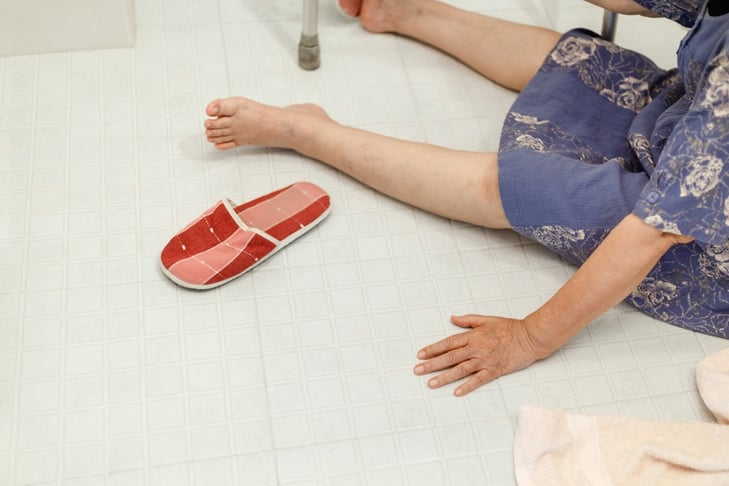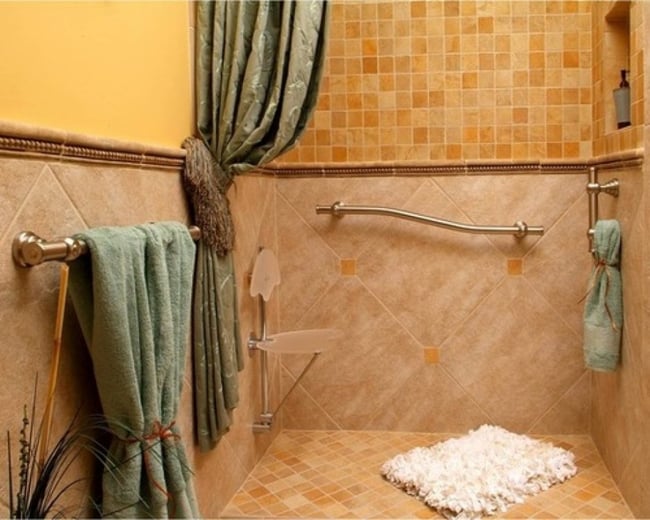
As we roll into September, we here at Marjorie P. Lee Retirement Community want to help you make sure that the only falls you witness this month are those of the leaves from the trees.
In anticipation of Fall Prevention Awareness Day on Sept. 22, today we’ll review with you some simple steps you can take to prevent falls and keep your senior loved ones safe.
Help your parents to make their homes safer
Many falls are caused by avoidable circumstances: clutter, slippery surfaces, trips over furniture and so on. One of the best tactics for keeping parents who are aging in place safe is to help them help them make their own homes safer.
Here are some things you can do:
1. Rearrange the furniture.
Widen spaces between furniture pieces, if there’s room. If not, move superfluous furnishings to an unused spare room, basement, or a storage unit. Better yet, convince your parents to sell or donate any of their unneeded furniture.
2. Install non-slip mats in the bathroom, kitchen and hallways.
Try the “sock test.” If a linoleum or tile floor is slick when you walk on it in only your socks, it needs a non-slip mat. The same goes for heavily traveled hallways.
3. What to do about hardwood floors?
Hardwood is a bit trickier to deal with. It looks wonderful and can improve a home’s value, so it’s tough to make the call to rip it out or carpet it over, especially if your parents are keeping an eye toward an eventual sale of their home.
They could purchase area rugs to put down. But those can present a tripping hazard in and of themselves.
So, this one’s a judgment call. You and your parents should discuss it carefully. If they really don’t want to put in carpet and area rugs aren’t an ideal answer, maybe it would be better to consider moving into a senior apartment in a retirement community.

4. Install grab bars in bathrooms and bedrooms and handrails in hallways.
Getting into and out of the bathtub or shower, standing up after using the toilet or even getting out of bed in the morning can be tricky for older parents who have arthritis or other mobility-limiting conditions. Wall-mounted grab bars can allow them to brace and get a little more leverage, making transitions easier on painful joints.
They’re also a safety device. When a person falls, he or she will often try to reach out and grab hold of something to stop downward motion. So handrails in the hallways are a good idea for the same reason.
5. Install raised toilet seats.
See above. These are essential for safeguarding elders who have difficulty moving from a sitting to a standing position.
6. Stay vigilant about medications.
Make sure your parents are taking their daily medications. A missed blood pressure pill in the morning can easily result in a mid-afternoon fall. If they’re not using a pill minder or medication reminder app, show them how to do so.
Conversely, too many medications (polypharmacy) can cause adverse drug interactions, including lightheadedness, dizziness, or confusion, that result in falls. If your parents take several medications on a regular basis, make sure you’re monitoring them for drug safety.
7. Invest in a life monitoring service.
Sure, the commercials are cheesy. But falls are a serious problem. A wearable-based life monitoring service could help your parent reach help when he or she can’t reach the phone. If your parent is digital savvy, many mobile applications provide similar capabilities.
Before your older parents come to visit, fall-proof your own home
When aging parents come to visit us, or when they temporarily come to stay with us after being discharged from the hospital or from a short-term rehab stay, it’s always a good idea to take steps to make your home as safe as possible to minimize their risk of falling.
Simple obstacles that we take for granted – a chair out of place here, a dog toy left out on the floor there – can pose a real danger to an older loved one who has limited mobility.
Here are some tips for fall-proofing your home, to accommodate your parents’ needs:
8. Tidy up.
Your parent may not care if your home is a mess, but untidiness can pose problems.
Load of laundry on the couch, waiting to be folded? Put it away before your parents arrive to visit, or at least put it in an area that they are unlikely to enter (back in the laundry room, the basement, a linen closet).
Put away stacked-up bills, loose papers, remote controls and other items that could slip off tables and present hazards.
9. Kids, put away your toys.
When grandma and grandpa come to visit, children naturally get excited and want to show off their latest playthings. Unfortunately, younger children aren’t always the best about putting things back in their proper places.
Toys left on the floor or on furniture can easily trip up an older person who may not be able to step over them, or whose eyesight is poor. Keep a close eye on your kids, and remind them to put away each toy when they are no longer using them. If you see something out of place, pick it up and put it away before it becomes a hazard.
10. Crate up the pets.
Like your kids, pets can become overly excited when a visitor arrives. You don’t want Fido jumping up on Dad and knocking him over just as he gets in the door.
Similarly, even if your pet is well behaved, you don’t want it accidentally getting underfoot while your parent is walking in your home. Put your pooch or kitty in its pet crate, or put it in a room no one will enter during the visit (just remember to provide it plenty of food, water and/or litter).
If your parent is staying with you for an extended visit, or following discharge from a short-term physical rehabilitation facility, you might want to consider boarding your pets for a little while.
A little forethought can prevent the majority of falls.
With Fall Prevention Awareness Day coming up this month, now’s the time to use these tips to keep your aging parents safer. We’d rather your elderly loved one stay safe and sound at home than to come to us for a short-term rehab stay after a preventable fall-related injury.










